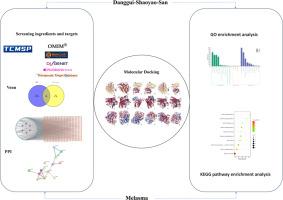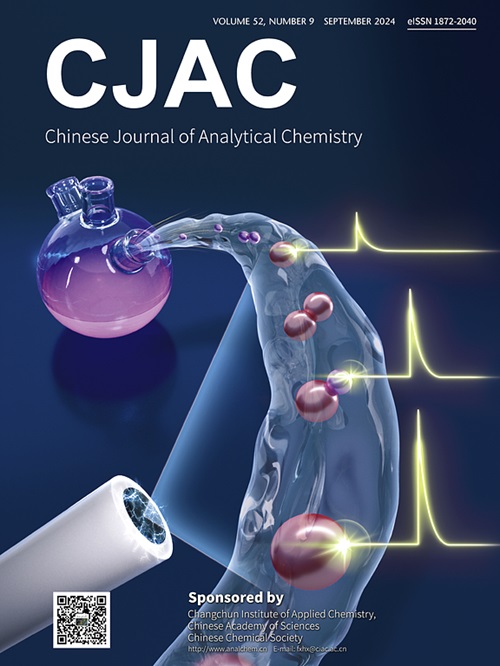基于网络药理学与分子对接的当归芍药散治疗黄褐斑的潜在分子机制
IF 1.3
4区 化学
Q4 CHEMISTRY, ANALYTICAL
引用次数: 0
摘要
虽然当归芍药散(DSS)在中国常用于治疗黄褐斑,但其潜在机制仍有待进一步了解。我们的目的是通过网络药理学(NP)确定党参皂苷治疗黄褐斑的机制。通过访问 TCMSP 数据库和 SwissTargetPrediction,确定 DSS 活性化合物和相应的靶基因。与黄褐斑相关的靶基因则从 GeneCards、DisGeNet、Durgbanks、OMIM 和 TTD 数据库中获取。接着,我们通过 Cytoscape 软件建立了一个成分-靶标关联网络,同时利用 STRING 数据库生成了一个蛋白质-蛋白质相互作用网络。随后,我们确定了核心靶基因和活性化合物。通过 DAVID 数据库和生物信息学工具,进行了基因本体(GO)和京都基因组百科全书(KEGG)富集分析。最后,使用 CB-Dock2 服务器进行分子对接(MOD)。结果表明,阿利索尔 B、麦角甾醇和瓦利西利内酯等是 DSS 中的活性化合物,而 PTGS2、ESR1 和 ESR2 是核心靶基因。GO 和 KEGG 分析表明,潜在的核心药物成分通过对生物过程施加影响,调节了癌症、化学致癌物-受体激活、钙、松弛素和雌激素信号转导的通路。这些过程包括基因表达负调控以及细胞膜钙离子浓度和 RNA 聚合酶 II 启动子转录的正调控,从而发挥抗黄褐斑的药理作用。MOD 显示,核心靶基因与活性化合物具有良好的结合活性。总之,NP 证明了 DSS 可作为治疗黄褐斑的创新药物。本文章由计算机程序翻译,如有差异,请以英文原文为准。

Potential molecular mechanisms of Danggui-Shaoyao-San in the treatment of melasma based on network pharmacology with molecular docking
Although Danggui-Shaoyao-San (DSS) is frequently used in China to treat melasma, its underlying mechanism still needs to be better understood. Our aim is to determine the mechanism behind DSS in treating melasma through network pharmacology (NP). The DSS active compounds alongside corresponding target genes are identified by accessing the TCMSP database and SwissTargetPrediction. Melasma-associated targets are retrieved from the GeneCards, DisGeNet, Durgbanks, OMIM, and TTD databases. Next, we build a component-target association network via Cytoscape software while generating a protein-protein interaction network utilizing the STRING database. Subsequently, both core target genes and active compounds are determined. Through the DAVID database and Bioinformatics tools, Gene Ontology (GO) and Kyoto Encyclopedia of Genes and Genomes (KEGG) enrichment analyses are conducted. Lastly, the CB-Dock2 server is deployed to conduct molecular docking (MOD). The results manifest that alisol B, cerevisterol, and Wallichilide, among others, are active compounds in DSS, while PTGS2, ESR1, and ESR2 are core target genes. Both GO and KEGG analyses showcase that the potential core drug components modulate pathways in cancer, chemical carcinogenesis-receptor activation, calcium, relaxin, and estrogen signaling by exerting their effects on biological processes. These processes include negative gene expression regulation as well as positive regulation of both cytosolic calcium ion concentration and transcription from the RNA polymerase II promoter, thereby playing an anti-melasma pharmacological role. The MOD displays that core target genes have good binding activity with the active compounds. To conclude, NP demonstrates that DSS can serve as an innovative medication for treating melasma.
求助全文
通过发布文献求助,成功后即可免费获取论文全文。
去求助
来源期刊
CiteScore
3.60
自引率
25.00%
发文量
17223
审稿时长
35 days
期刊介绍:
Chinese Journal of Analytical Chemistry(CJAC) is an academic journal of analytical chemistry established in 1972 and sponsored by the Chinese Chemical Society and Changchun Institute of Applied Chemistry, Chinese Academy of Sciences. Its objectives are to report the original scientific research achievements and review the recent development of analytical chemistry in all areas. The journal sets up 5 columns including Research Papers, Research Notes, Experimental Technique and Instrument, Review and Progress and Summary Accounts. The journal published monthly in Chinese language. A detailed abstract, keywords and the titles of figures and tables are provided in English, except column of Summary Accounts. Prof. Wang Erkang, an outstanding analytical chemist, academician of Chinese Academy of Sciences & Third World Academy of Sciences, holds the post of the Editor-in-chief.

 求助内容:
求助内容: 应助结果提醒方式:
应助结果提醒方式:


